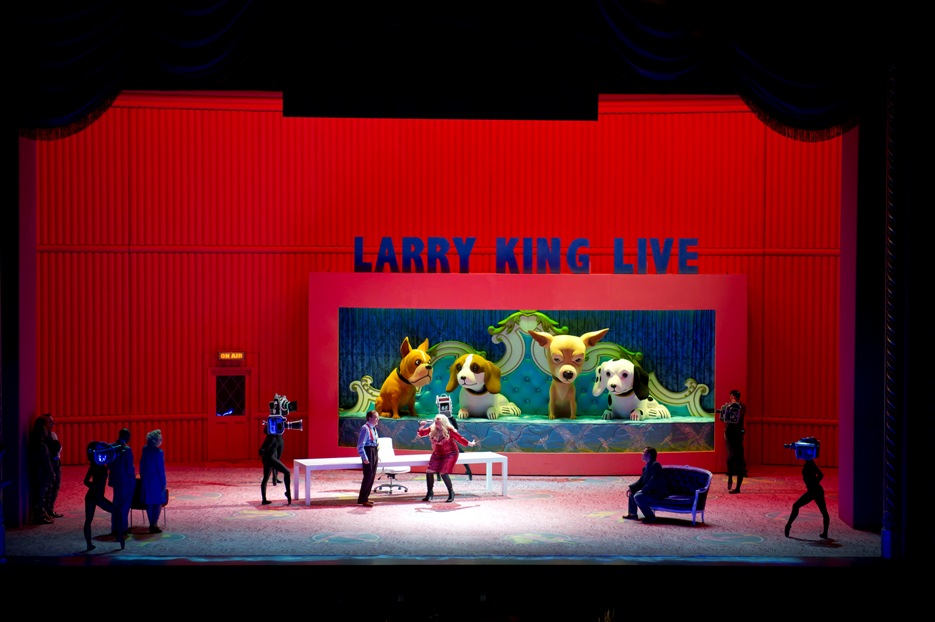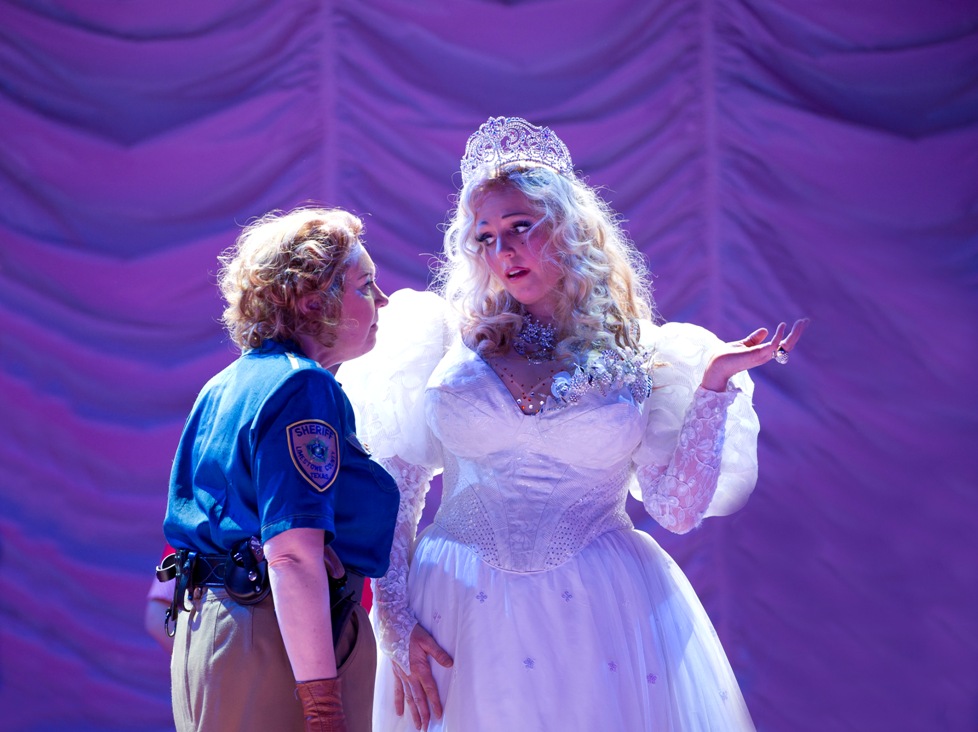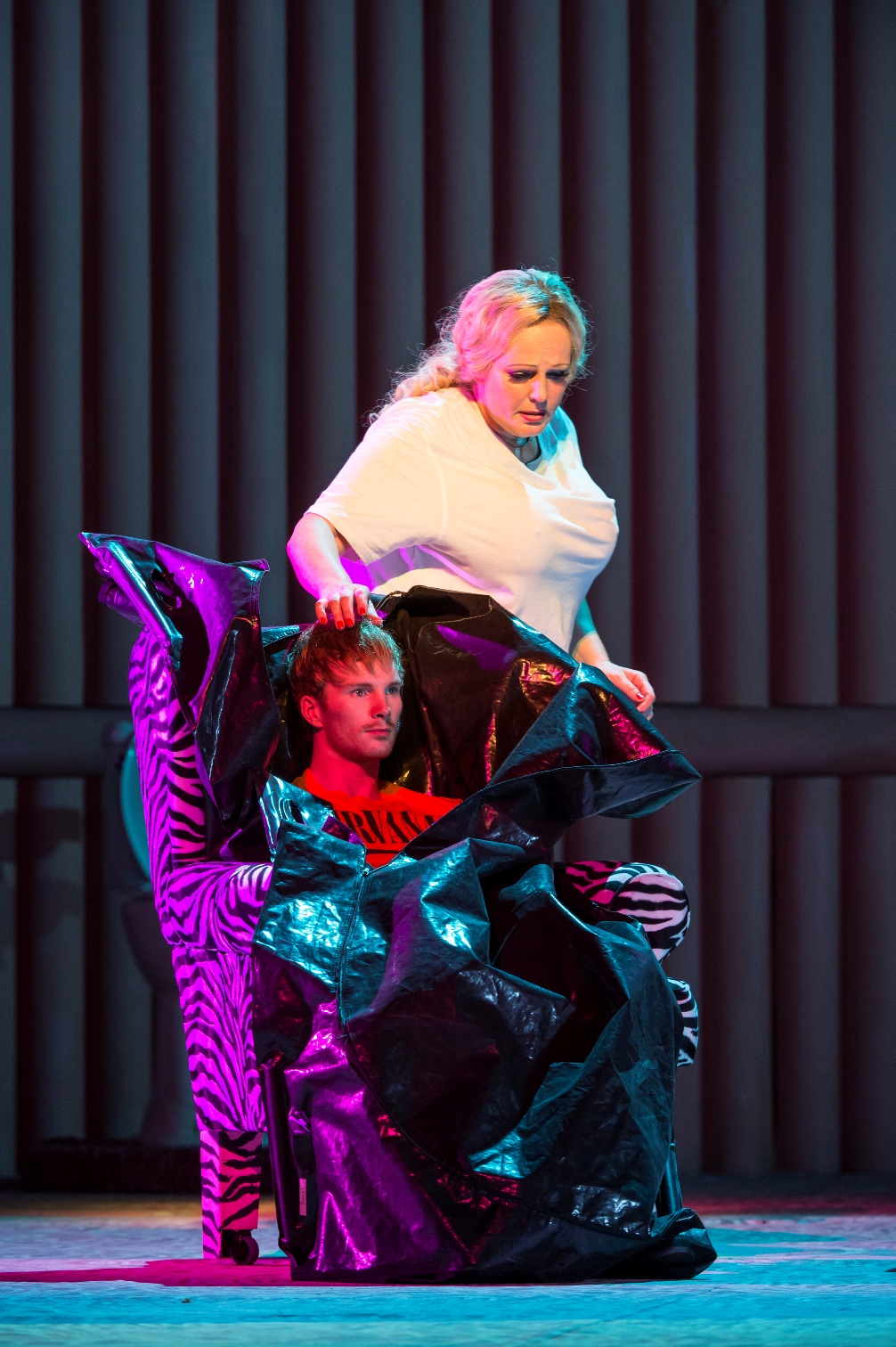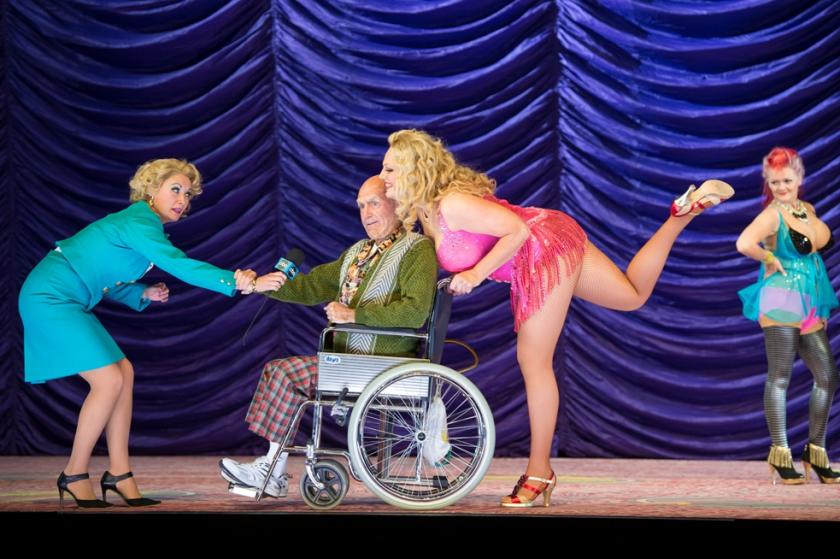Even before I stepped into the Royal Opera House, it was clear to see that it had been transformed for the opening performance of Mark-Anthony Turnage’s Anna Nicole. A red carpet outside; the pervasive smell of popcorn within; the stage curtains, usually red, now a gaudy shade of purple: the opera house clearly had a case of All Things American.
This exciting atmosphere was upheld throughout the opera, which was unlike anything I had ever seen. Its theme is the life of the world’s first reality TV star, Anna Nicole Smith, whose short life was filled with controversy (marrying a billionaire octogenarian at the age of 26), tragedy (the untimely death of her beloved son only three days after the birth of her daughter), and paparazzi. In keeping with this life lived in front of the cameras, and relying rather heavily on cultural stereotypes, the visible spectacle was relentlessly big, brash and bright. Gaudy costumes, a dazzling Gentleman’s Club set, and giant plastic Bambi figurines (pictured below) were just some of the highlights of Richard Jones's production.
 These weren’t just there for show, however, but cleverly thought through. The use of changing costumes for the lead character Anna Nicole, in particular, highlighted her meteoric rise to fame. The garish lighting, which seemed to only have three settings (completely on, bright pink, or completely off) was a constant reminder of Anna’s lack of privacy, with nowhere to hide, not even after death.
These weren’t just there for show, however, but cleverly thought through. The use of changing costumes for the lead character Anna Nicole, in particular, highlighted her meteoric rise to fame. The garish lighting, which seemed to only have three settings (completely on, bright pink, or completely off) was a constant reminder of Anna’s lack of privacy, with nowhere to hide, not even after death.
The many cultural references also reinforced the opera’s image as a work for today, as did Richard Thomas’s libretto. Exceedingly colloquial to the point of vulgarity, the references ranged from the high-brow Requiem text to Star Wars and petty swearing matches. The true measure of the libretto, however, was in Thomas’ ability to make the audience laugh out loud at the same time as provoking thought (even if the unremitting rhyming couplets grew a little wearing).
The focus on the world of today was also heard in Turnage’s score. Described as an amalgam of jazz, blues, music theatre, more conventional operatic language and TV music, I found it a little disappointing. It was at once kaleidoscopic and eclectic, yet strangely all rather the same; it was quite like the “easy listening” genre, yet a touch too dissonant for the popular palette. In style it reminded me in places of the musical Sweeney Todd, but with rather less memorable tunes.
The orchestra/pit band conducted by Sir Antonio Pappano sounded, dare I say it, rather like backing music. It seemed designed to set the scene aurally, but beyond that did not really add to the action, and I fear that without this particular staging, the performance would lose most of its power. This is the fatal flaw of Anna Nicole as an opera, as a score of this kind should be able to stand up on its own two feet and survive different interpretations.
 The singing and acting in this production, on the other hand, were excellent. Eva-Maria Westbroek’s Anna (pictured left with Susan Bickley's Virgie) was utterly compelling, ranging a full stretch of emotions from childish tantrums to lyric grief, with changes in vocal colour to match. All performers, including the chorus, were committed to even the most stereotypical of roles, and were of a very high musical standard throughout. Special mention must go to Alan Oke (J Marshall II) whose performance was particularly engaging.
The singing and acting in this production, on the other hand, were excellent. Eva-Maria Westbroek’s Anna (pictured left with Susan Bickley's Virgie) was utterly compelling, ranging a full stretch of emotions from childish tantrums to lyric grief, with changes in vocal colour to match. All performers, including the chorus, were committed to even the most stereotypical of roles, and were of a very high musical standard throughout. Special mention must go to Alan Oke (J Marshall II) whose performance was particularly engaging.
Anna Nicole was an enjoyable production of a high standard. However, it left me puzzled and unsatisfied, for the simple reason that while it confronts big issues, it leaves its ultimate message unclear. Throughout the opera, the aim is clearly to offer social criticism of some kind: on the press, plastic surgery, the humdrum existence of low-wage workers, and more. This is shown through heavily stylised visual effects such as the use of dark figures with cameras instead of heads, which follow Anna around, and Wallmart workers with dummy-like masks.
While these work very well, the onstage press, whose presence frames the whole opera, acts as a distancing effect which weakens the humanity of its message. Like a Greek chorus they filter our view, meaning we don’t know what to believe, particularly with regards to Anna herself. If the whole point is to emphasise the distorting view of the press, then how can we decide whether prejudices against Anna are unbiased, particularly when we are simultaneously invited to laugh at her and empathise with her?
 One might expect, in this situation, for the music to guide our response. This was not to be the case, however, as the music was contradictory, at times matching our expectations, at others seemingly ironic (or perhaps down-right out of place). It was hard to hear what Turnage intended, for example, with the announcement of Daniel’s death (Westbroek pictured right with Jason Broderick as the teenage Daniel)– accompanied at first with dreamy, major-key music, which suddenly snapped to a more conventionally dissonant outpouring, with no real reason to do so. We’re left with the uncomfortable feeling that the portrayal of Anna’s life may well be as fake as her “silicone titties”.
One might expect, in this situation, for the music to guide our response. This was not to be the case, however, as the music was contradictory, at times matching our expectations, at others seemingly ironic (or perhaps down-right out of place). It was hard to hear what Turnage intended, for example, with the announcement of Daniel’s death (Westbroek pictured right with Jason Broderick as the teenage Daniel)– accompanied at first with dreamy, major-key music, which suddenly snapped to a more conventionally dissonant outpouring, with no real reason to do so. We’re left with the uncomfortable feeling that the portrayal of Anna’s life may well be as fake as her “silicone titties”.
I’d certainly recommend anyone over 16 to see the Royal Opera House’s production of Anna Nicole. It's a feast for the senses, with a finely crafted libretto. However, be prepared to be a little disappointed with the score, and be ready to have to make up your own mind as to what the opera is really trying to say.















Add comment